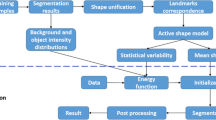Abstract
Automatic segmentation of the hip joint with pelvis and proximal femur surfaces from CT images is essential for orthopedic diagnosis and surgery. It remains challenging due to the narrowness of hip joint space, where the adjacent surfaces of acetabulum and femoral head are hardly distinguished from each other. This chapter presents a fully automatic method to segment pelvic and proximal femoral surfaces from hip CT images. A coarse-to-fine strategy was proposed to combine multi-atlas segmentation with graph-based surface detection. The multi-atlas segmentation step seeks to coarsely extract the entire hip joint region. It uses automatically detected anatomical landmarks to initialize and select the atlas and accelerate the segmentation. The graph based surface detection is to refine the coarsely segmented hip joint region. It aims at completely and efficiently separate the adjacent surfaces of the acetabulum and the femoral head while preserving the hip joint structure. The proposed strategy was evaluated on 30 hip CT images and provided an average accuracy of 0.55, 0.54, and 0.50 mm for segmenting the pelvis, the left and right proximal femurs, respectively.
Access this chapter
Tax calculation will be finalised at checkout
Purchases are for personal use only
Similar content being viewed by others
References
Kang Y, Engelke K, Kalender A (2003) A new accurate and precise 3D segmentation method for skeletal structures in volumetric CT data. IEEE Trans Med Imaging 22(5):586–598
Zoroofi RA, Sato Y, Sasama T, Nishii T, Sugano N, Yonenobu K, Yoshikawa H, Ochi T, Tamura S ( 2003) Automated segmentation of acetabulum and femoral head from 3-D CT images. IEEE Trans Inf Technol Biomed 7(4):329–343
Cheng Y, Zhou S, Wang Y, Guo C, Bai J, Tamura S (2013) Automatic segmentation technique for acetabulum and femoral head in CT images. Pattern Recogn 46(11):2969–2984
Lamecker H, Seebaß M, Hege HC, Deuflhard P (2004) A 3D statistical shape model of the pelvic bone for segmentation. In: SPIE 2004, vol. 5370, pp 1341–1351
Seim H, Kainmueller D, Heller M, Lamecker H, Zachow S, Hege HC (2008) Automatic segmentation of the pelvic bones from CT data based on a statistical shape model. In: VCBM 2008, pp 93–100
Kainmueller D, Lamecker H, Zachow S, Hege HC (2009) An articulated statistical shape model for accurate hip joint segmentation. In: IEEE EMBC, pp 6345–6351
Yokota F, Okada T, Takao M, Sugano S, Tada Y, Sato Y (2009) Automated segmentation of the femur and pelvis from 3D CT data of diseased hip using hierarchical statistical shape model of joint structure. In: MICCAI 2009, part II, pp 811–818
Yokota F, Okada T, Takao M, Sugano S, Tada Y, Tomiyama N, Sato Y (2013) Automated CT segmentation of diseased hip using hierarchical and conditional statistical shape models. In: MICCAI 2013, part II, pp 190–197
Ehrhardte J, Handels H, Plotz W, Poppl SJ (2004) Atlas-based recognition of anatomical structures and landmarks and the automatic computation of orthopedic parameters. Methods Inf Med 43(3):391–397
Pettersson J, Knutsson H, Borga M (2006) Automatic hip bone segmentation using non-rigid registration. In: ICPR 2006, pp 946–949
Xia Y, Fripp J, Chandra SS, Schwarz R, Engstrom C, Crozier S (2013) Automated bone segmentation from large field of view 3D MR images of the hip joint. Phys Med Biol 58:7375–7390
Li K, Wu X, Chen DZ, Sonka M (2006) Optimal surface segmentation in volumetric images A graph-theoretic approach. IEEE Trans Pattern Anal Mach Intell 28(1):119–134
Song Q, Wu X, Liu Y, Smith M, Buatti J, Sonka M (2009) Optimal graph search segmentation using arc-weighted graph for simultaneous surface detection of bladder and prostate. In: Proceedings of MICCAI, vol 5762, pp 827–835
Thirion JP (1998) Image matching as a diffusion process: an analogy with maxwell™s demons. Med Image Anal 2:243–260
Knutsson H, Andersson M (2005) Morphons: segmentation using elastic canvas and paint on priors. In: IEEE international conference on image processing (ICIP05), Genova, Italy, Sep 2005
Breiman L (2001) Random forests. Mach Learn 45(1):5–32
Criminisi A, Shotton J, Robertson D, Konukoglu E (2010) Regression forests for efficient anatomy detection and localization in CT studies. MCV 2010:106–117
Lindner C, Thiagarajah S, Wilkinson JM, arcOGEN Consortium, Wallis G, Cootes TF (2013) Fully automatic segmentation of the proximal femur using random forest regression voting. IEEE Trans Med Imag 32(8):1462–1472
Chu C, Chen C, Liu L, Zheng G (2014) FACTS: fully automatic CT segmentation of a hip joint. Ann Biomed Eng. doi:10.1007/s10439-014-1176-4
Glocker B, Komodakis N, Tziritas G, Navab N, Paragios N (2008) Dense image registration through MRFs and efficient linear programming. Med Image Anal 12(6):731–741
Boykov Y, Jolly MP (2000) Interactive organ segmentation using graph cuts. In: Proceedings of medical image computing and computer-assisted intervention (MICCAI), pp 276–286
Chu C, Oda M, Kitasaka T, Misawa K, Fujiwara M, Hayashi Y, Nimura Y, Rueckert D, Mori K (2013) Multi-organ segmentation based on spatially-divided probabilistic atlas from 3D abdominal CT images. In: MICCAI 2013, part II, pp 165–172
Liu L, Ecker T, Schumann S, Siebenrock K, Nolte L, Zheng G (2014) Computer assisted planning and navigation of periacetabular osteotomy with range of motion optimization. In: MICCAI 2014, vol 8674, pp 643–650
Kolmogorov V, Zabih R (2004) What energy functions can be minimized via graph cuts? IEEE Trans PAMI 26:147–159
Author information
Authors and Affiliations
Corresponding author
Editor information
Editors and Affiliations
Rights and permissions
Copyright information
© 2016 Springer International Publishing Switzerland
About this chapter
Cite this chapter
Chu, C., Bai, J., Wu, X., Zheng, G. (2016). Fully Automatic Segmentation of Hip CT Images. In: Zheng, G., Li, S. (eds) Computational Radiology for Orthopaedic Interventions. Lecture Notes in Computational Vision and Biomechanics, vol 23. Springer, Cham. https://doi.org/10.1007/978-3-319-23482-3_5
Download citation
DOI: https://doi.org/10.1007/978-3-319-23482-3_5
Published:
Publisher Name: Springer, Cham
Print ISBN: 978-3-319-23481-6
Online ISBN: 978-3-319-23482-3
eBook Packages: EngineeringEngineering (R0)




